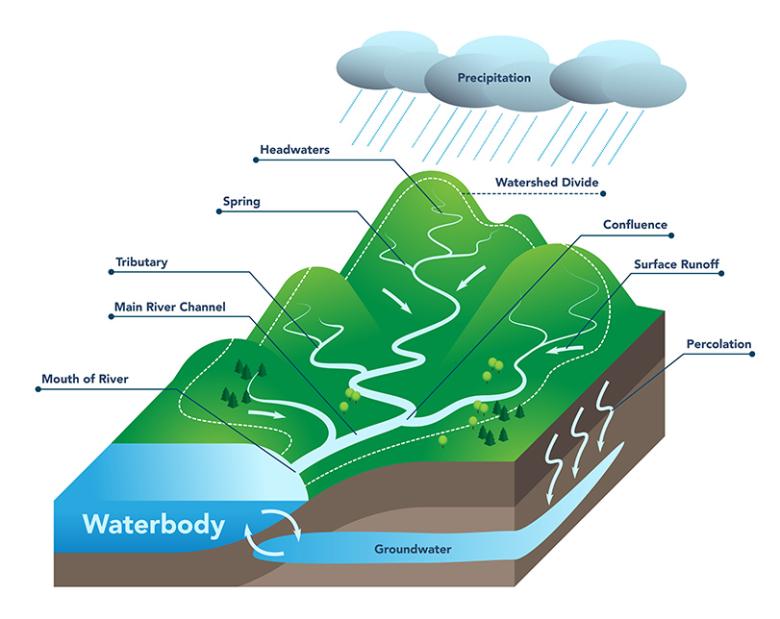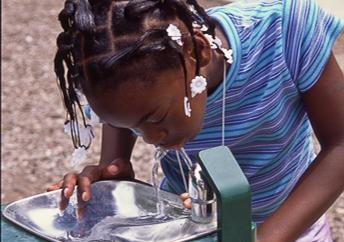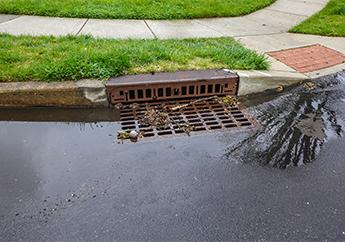Division of Environmental Quality Director: Kyra Moore

Water is the most basic natural resource and is essential for all life. Everybody needs clean water – from the people who drink it and fish and swim in it, to the critters that live in it or depend on it for their food, to the industries that rely on it to make and grow things. And cleaner water begins in a watershed.
What is a watershed?
A watershed is the area of land that collects and drains water to one point – every lake, river and stream has its own watershed. Watershed boundaries are landscape features - like hills and ridges - that direct the flow of water. Watersheds can be as small as a few city blocks or a farm field, or cover entire states or regions like the Mississippi River watershed. Smaller watersheds nest inside larger ones, with one’s waters flowing downstream to the next. A group of watersheds that drain into a major waterbody is often referred to as a basin. For instance, all of the land that drains into the Missouri River from Three Forks, Montana to St. Louis is referred to as the Missouri River Basin. Watersheds can be divided into smaller watersheds, such as an area surrounding a small creek or stream.
We all live in a watershed.
Watersheds are important because they provide us with water for drinking, recreation, industry and agriculture. Lakes, rivers, streams and wetlands are homes for many kinds of animals, insects and plants. How we use the land can affect watersheds and the quality of the water resources they provide.
What is an example of watershed?
The East Fork of Shoal Creek and the land that drains into it is referred to as the East Fork Shoal Creek Watershed. Located in Kansas City’s Northland between the urban centers of Liberty and Gladstone, the watershed covers approximately 14 square miles including Hodge Park. The East Fork of Shoal Creek runs through Hodge Park, draining to the South and flows into Shoal Creek which eventually empties into the Missouri River.
Why is my watershed important?
Watersheds provide water for drinking, irrigation and industrial processes. Many people also enjoy and use lakes and streams for their beauty, boating, fishing and swimming. Wildlife also need healthy watersheds for food and shelter.
How does water – and pollution – get from the land into our waters?
Water quality is a major concern in a watershed. Water quality problems can result from a wide variety of activities. Pollution can occur from factories, wastewater treatment plants or large confined animal feeding operations that discharge into a waterway. These types of point source pollutants are often traced back to a specific point of discharge. Nonpoint source pollution, however, is a major type of pollution that can be difficult to identify and measure. Nonpoint source pollutants are in the water that runs off crop or forest land. Other nonpoint sources include failing septic systems, parking lots, construction sites, irrigation systems and drainage systems. It can even result from automobile exhaust getting into the atmosphere and falling back to earth in the rain.
Most of us have seen streams filled to the tops of their banks during storms. But how often do we think about how all that water gets there? When it rains or snow melts, some of that water soaks into the soil. Whatever water the soil cannot absorb travels across the land, becoming runoff. This runoff will likely end up in the nearest waterbody, such as a stream, river, pond, lake or wetland. As runoff flows to the nearest waterbody, it often picks up contaminants that can pollute our waters, such as soil particles, bacteria, oils, salts, fertilizers and pesticides. Polluted runoff is known as nonpoint source pollution and is the greatest threat to Missouri’s waters. It can make water unsafe for humans to drink or swim in and make it difficult for fish and other creatures that live in it to survive or thrive.
Water that is absorbed by the soil may be used by plants or it may enter the groundwater system. Groundwater flows like a very slow underground river, often ending up in a nearby stream or other waterbody. The soil and rocks that the groundwater flows through acts as a filter by removing pollutants from the water. However, not all nonpoint source pollution can be filtered out, making it a concern for the many Missourians that use groundwater for drinking.
Who is responsible for my watershed?
Point sources are regulated under the Clean Water Act and are usually subject to permit requirements that focus on water quality protection. Nonpoint source pollution typically is unregulated and can be addressed by citizens, farmers and educators on a volunteer basis. The responsible parties may include citizens, industries, agribusinesses, commercial businesses or homeowners.

How does watershed health affect me?
Watersheds that are managed with sustainable land use practices that promote soil health provide water to streams, rivers, lakes and wetlands that is of high quality and desirable quantity. Healthy watersheds have many benefits:
- They provide clean water needed for safe drinking water, safe and enjoyable recreation, and thriving aquatic life and wildlife.
- They help reduce impacts of climate and land use change.
- They provide many economic benefits such as:
- Reducing costs for treating and supplying water for drinking and for industrial uses.
- Increasing tourism by providing good places to fish, swim and boat.
- Increasing property values.
- Reducing damage caused by floods.
How do cities and suburbs affect watersheds?

How land is used in urban areas can affect water quality in a number of ways:
- Hard surfaces like parking lots, buildings, roads and driveways keep runoff from soaking into the soil. Water that runs off these surfaces is call stormwater and it travels directly into surface waters through stormwater drains and storm sewers without being filtered by soil or treated in any way. Stormwater runoff carries sediment, oils, fertilizer, bacteria and pesticides straight to nearby streams. And less water soaking into the ground results in high volumes of urban runoff that can cause erosion and flooding in streams – damaging habitat, property and infrastructure.
- FIX: Low Impact Development and Green Infrastructure (LID/GI) refer to practices that use or imitate natural processes in order to protect water quality and stream stability. These practices often use native plantings in holding areas that capture runoff and to allow it to slowly soak into the soil, be taken up by the plants, or be used for other purposes. Examples of LID/GI practices include bioretention facilities, rain gardens, vegetated rooftops, rain barrels and permeable pavements.
- Soil and debris from construction projects can be carried to streams through runoff
- FIX: Use erosion control measures such as silt fences around construction sites. Encourage development plans that include rain gardens, stormwater retention basins and green space.
- Fertilizers used on lawns and golf courses may end up in streams and lakes through runoff.
- FIX: Test soil and do pest scouting so that fertilizers and pesticides are more accurately applied. Keep or plant a filter strip of vegetation along streams and lakes to slow down polluted stormwater runoff and allow it to soak into the ground before it reaches the water. Install a rain garden to capture and clean stormwater runoff before it leaves your property.
- Pet waste may reach streams in runoff, causing bacteria problems
- FIX: Pick up your pet’s waste and put it in the trash. Consider local ordinances that require people to pick up after their pets.
- Wastewater treatment plants contribute nutrients to waterways. They sometimes overflow, allowing untreated wastewater to enter a stream.
- FIX: Consider bond issues to raise money to build or upgrade your local wastewater treatment plants to help keep bacteria and other pollutants from nearby waters.
- Underground storage tanks for chemicals, such as gasoline, may rupture, leaking into groundwater
- FIX: Properly install and maintain storage tanks. Call the department’s Environmental Emergency Response immediately if a leak or spill occurs.
- Aquatic habitats in urban streams are often highly modified and degraded due to channel straightening, culverts and concrete basins
- FIX: Support projects that naturalize urban streams.
How do farms affect watersheds?
Rural land uses also affect water quality in many ways:
- Fertilizers and pesticides from crop fields are often found in runoff in rural areas and can promote algae blooms, impair drinking water, or harm aquatic life.
- FIX: Apply chemicals only in the amounts and locations necessary. Use conservation practices to minimize runoff: nutrient management plans, cover crops, field borders, filter strips, terraces and others.
- Surface runoff from crop fields may carry large amounts of soil, causing field erosion and potentially filling in lakes, rivers and streams, and habitat for aquatic life with sediment. Eroded soil also acts as a carrier to transport bacteria, fertilizers, and pesticides into waterways.
- FIX: Use conservation practices to minimize runoff: cover crops, no-till, contour stripcropping, field borders, filter strips, grass waterways, terraces and others.
- Cattle in pastures with direct access to streams often trample the streambank, leading to soil erosion and water pollution.
- FIX: Use conservation practices: livestock exclusion from streams with alternative water sources.
- Livestock waste may reach surface waters in runoff, causing algae blooms and bacteria problems
- FIX: Use conservation practices: rotational grazing, livestock exclusion from streams, animal waste management and others.
- Septic systems that are not properly constructed or maintained can send bacteria into streams
- FIX: Keep your septic tank properly maintained by having it pumped every two to three years. Use septic systems appropriate for the site.
- Storage tanks for chemicals like pesticides and fertilizers may rupture, causing fish kills and contaminating groundwater.
- FIX: Properly install and maintain storage tanks. Call the department’s Environmental Emergency Response immediately if a leak or spill occurs.
What can I do?
We each play a part in promoting and preserving clean water.
It’s up to each of us to make changes individually and to come together in groups to make a difference. Get to know your watershed. Become familiar with the activities in your watershed so you can better understand water resource problems that need to be addressed.
- Go to public meetings or hearings about water resource problems. In the planning process, public participation by informed citizens fosters quality development with minimal impact to water quality. Implement best management practices where possible.
- Join a volunteer water quality monitoring team.
- Join or form your own Stream Team to learn how watersheds work and how to care for them, to clean up local streams and even how to monitor water quality.
- Consider supporting stormwater management initiatives and bond issues to raise money to build or upgrade your local wastewater treatment plants to help keep bacteria and other pollutants from nearby waters. You can rally others in your community to create a watershed improvement project to make changes on the land for better water quality.
- If you are a property owner or farmer, use best management practices to help keep runoff from leaving your property. If you live on a farm, maintain filter strips on the edges of your fields, terrace your row crops and mix your chemicals away from the well. Ask your county extension agent about rotational grazing, a practice that prevents erosion and unnecessary reseeding, provides cleaner water for livestock and protects nearby streams and creeks.
- There are also ways to help at home: put in a rain garden, never dump anything down a storm drain, plant trees along a creek bank, keep cars and trucks maintained to reduce the amount of chemicals leaking onto roads and driveways and don’t flush medicines down the toilet – dispose of your expired or unused medicines at area drop-off centers or events.
- As a resident, limit your use of lawn fertilizers and pesticides or investigate alternatives. In the garden or landscaped areas, cover exposed soil with mulch or hay to prevent soil erosion. Do soil testing and pest scouting so fertilizers and pesticide applications can be more accurately applied.
- Keep your automobile maintained to reduce the amount of oil, grease and other lubricants leaking onto roads and driveways.
- Dispose of used oil and household chemicals properly.
Funding for Watershed Protection
Watershed protection takes funding as well as action. Here are some resources that can help:
- Section 319 Nonpoint Source Subgrants: Get funding for watershed planning and protection.
- Financial and technical assistance for farmers: Get help to implement conservation practices from the Department’s Soil and Water Conservation Program and your county Soil and Water Conservation District, and from the federal Natural Resources Conservation Service’s Environmental Quality Incentives Program (EQIP).
- Water Protection Program Financial Assistance Center: The department offers assistance through the State Revolving Fund to help communities plan, finance and build water infrastructure projects.
- Financial Assistance Opportunities brochure: The department offers help in the form of tax credits and exemptions, loans and grants.
- Funding Resources for Watershed Protection and Restoration: From the U.S. Environmental Protection Agency (EPA): help finding grants, loans, and cost-sharing opportunities.
Learn about Watersheds, Nonpoint Source and Water Quality
- Impaired Waters: Check out water quality conditions in Missouri.
- How’s My Waterway: Find your local watershed, plus data and local volunteer groups.
- U.S. EPA Watersheds page: The U.S. Environmental Protection Agency’s watersheds page.
- Missouri’s Nonpoint Source Management Plan: A plan to address nonpoint source pollution statewide.
- Source Water Protection Program: Learn about protection of sources for drinking water.
- State Water Planning: Learn about the plan to address long-term statewide water needs.
- U.S. EPA Water Topics page: Explore a variety of water quality topics.
- Tools and Resources for Watershed Planning and Improvement: Visit this page for additional resources.
Nothing in this document may be used to implement any enforcement action or levy any penalty unless promulgated by rule under chapter 536 or authorized by statute.
For more information
Section 319 Nonpoint Source Unit
Water Protection Program
Water Pollution Control Branch
P.O. Box 176
Jefferson City, MO 65102-0176
United States
